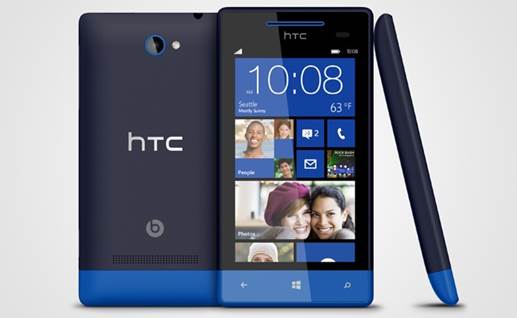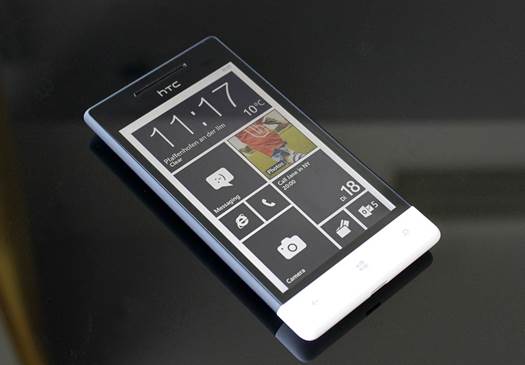We are not sure whether HTC’s One S
suffers from the middle child syndrome. Of course, it should not. But if it
does, it is an obstacle that the company has in store for its Windows Phone 8
phone series.
HTC decided that two would be enough, and
who are we to argue with them? It was back in October that we held the high-end
phone, but now its smaller and cheaper companion has arrived. At around $370 and
SIM-free, this potentially represents one of the best Windows Phone options
around at the moment (at least in Europe and Asia). For sure, Nokia's Lumia 620
will soon be earning some of its market share, but for now it's got relatively
little competition. So far, Windows Phone 8 has seen plenty of its opponents
running dual-core, 1.5GHz Snapdragon chips. This time we're looking at a slower
clock speed (1GHz) and some more silent specifications. Based on those, did HTC
get the balance between the cheap price and features right here? Go on reading to
find out.

HTC
Windows Phone 8S
Hardware
When we touched uor hands on the HTC 8X,
it's good enough to say that we were amazed with the design. We are pleased to
say we felt the same way as when we first met the smaller and more colorful 8S.
Here too, HTC's inspiration came from Windows Phone 8 itself, with clean traits
which dominate the overall aesthetic. While much of the design language mimics
its larger sibling, the 8S does have an identity of its own, and the most
obvious difference is the chin, which has a different color than the rest of
the device. Our review model is black and white, but there are more vivid color
options available, including the same blue shade offered on the 8X. Unlike its
big brother, however, the 8S isn't made from a unibody of polycarbonate, or if
it is, it certainly isn't one piece now.

That
chin is removable, and hides the phone's SIM and microSD card slots.
That chin is removable, and hides the
phone's SIM and microSD card slots (this should be a good time to remind
everyone that you won't be able to find a memory card reader on the 8X). We
definitely welcome the option to expand the 4GB internal storage (but quite
limited), and hiding it away here means that it doesn't interfere too much with
the overall design. However, the little plastic section can be difficult to
re-attach; it usually took us several attempts to do so. Once you've got it
back on appropriately, nonetheless, it stays good enough to create the illusion
to us that the device is just a solid pece. HTC might have given us access to
our SIM and memory cards, but you will have bad luck if you want to do so with
the 1,700mAh battery, as that's hidden away along with everything else that we
mentioned.
The back has a soft finish, and carves out
in a "pillow-like" style which is similar to that of the 8X. The 8S
might be smaller diagonally (with a 4-inch, rather than 4.3-inch, display), but
it's actually slightly thicker at 10.28mm (compared to 10.12mm). This is not
significantly noticeable, but if you hold both of them in your hands at the
same time, you can feel the 8S is a little bit too fat, compared to the other.
The rear is also the place where you'll find the 5MP camera, an embossed HTC
logo, a discreet Beats branding and also drilled speaker holes at the bottom. The
front is more plain, with the black screen and bezel which are only interfered
by the top grille which matches the main body’s color which is less noticeable
on the black version that we have here.
At the other end, on the colorful base are
the standard Windows Phone capacitive buttons. The glass front is entirely
flat, and lies on the same surface with the polycarbonate case - unlike the
slightly protruding and curved screen edges of the 8X. The sides are made slim,
but still are where the usual facilities are placed. In this case, we have a
headphone jack and power/standby button on the top, a micro-USB port lying in
the middle on the bottom, and a volume rocker on the right side. There's also a
dedicated camera button just beneath this, whereas there is nothing on the
other side to distract users with. This results in a phone that is wonderfully
easy to use with one hand, and the curved back means it fits your palm
comfortably at the same time.

The
display is WVGA (800 x 480).
The display is WVGA (800x480), which expresses
a modest pixel density of 233 ppi. There's Gorilla Glass 2 to protect it,
however, and the 4-inch non-PenTile RGB Super LCD looks bright and vibrant
despite its slightly low resolution. If you take a deep look at icons and
images close enough, you can definitely see the rougher edges, but you'll really
have to be looking for them cautiously. Blacks are displayed well enough, and
colors appear bright and balanced. Similar to what we saw with the 8X, the
range of viewing angles seems to be a little bit more limited than other HTC devices.
Keep searching deeper down, you'll find a
1GHz dual-core Qualcomm S4 Snapdragon along with 512MB of RAM, which makes the
specifications very similar to those of the HTC Desire X. Regarding radios, the
HTC 8S supports GSM/GPRS/EDGE (850/900/1800/1900 MHz) and UMTS/HSPA+
(900/2100MHz). Together with those, you'll also find Bluetooth 3.1 available and
801.11b/g/n, plus GPS and GLONASS antennas. So the main differences between
this and the 8X are fewer HSPA+ bands (the 8X also supports 1900 and 850) and
no NFC support.